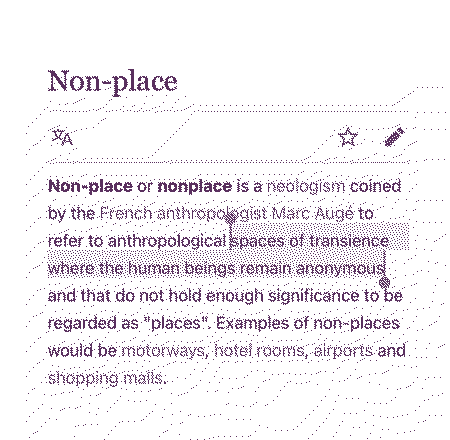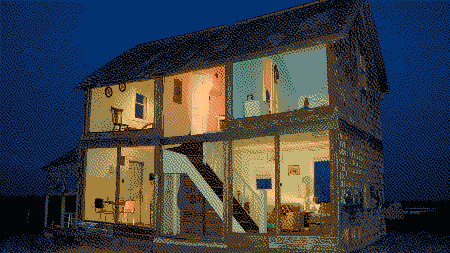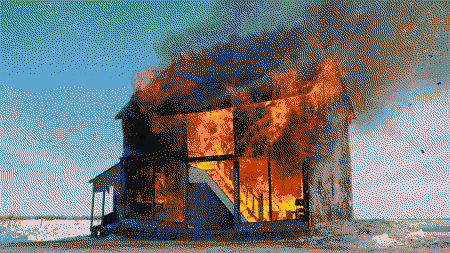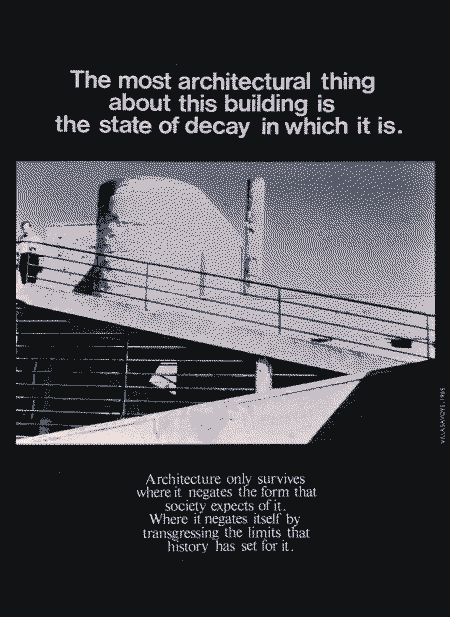- Shirley Jackson, The Haunting of Hill House
An Introduction:

at the risk of stating the obvious: we spend a lot of time in our houses, generally. if you've experienced unstable or unsafe housing, you're intimately familiar with how a place that's meant to represent safety can turn against you. if you haven't, then there's a chance you don't think that much about your house — the four walls of your room are dependable, floors firm, bricks neat, doors sensibly shut. the home is as it should be: a place that protects you from the elements and gives you a safe location in which to exist at your most vulnerable.
haunted houses, then, are the inversion of the ideal of the house. haunted houses make the home into a cage (& provide a lens through which to view real houses that have been cages for us). houses become haunted when something unspeakable happens in them, or when they are abandoned, or when they're built in the wrong place or using the wrong methods or by the wrong people.
haunted houses don't always have ghosts in them — i love a good ghost story, but the house itself is what interests me the most. i've got a fraught relationship with the concept of home. maybe you do, too. haunted houses are a way to express that relationship. a house that loves you; a house that hates you; a house that is more than the people and events and picture frames within it.
haunted houses can be a little bit of everything. every house can be a haunted house if you look closely enough.
Haunted House as Trope:
- Colin Dickey, Ghostland: An American History in Haunted Places

from that's believable
Formula for the Haunted House Tale
1. with an unsavory history
2. with an aristocratic name
3. disturbed by supernatural events usually unrelated to human ghosts
2. knowledgable helpers who believe in the supernatural
3. an oracular observer who warns of danger
1. an escalating series of supernatural events which isolates the family physically and psychologically
2. the discovery of provenance for those events
climax:
1. the escape of the family and the destruction of the house
1. the escape of the family and the continued existence of the house
2. a twist ending which establishes the recurring nature of evil
2. economic hardship
3. consequences of the past (especially unpunished crimes)
4. Manichean clash of good and evil
5. clash of scientific and supernatural world views
6. cyclical nature of evil
- Dale Bailey, American Nightmares: The Haunted House Formula in American Popular Fiction

We are afraid that someone will come into our house when we don’t want them to. We are afraid that the thing we fear is already inside. We are afraid we can’t make it leave. We are afraid the lock on the door will not hold.
- Kirsty Logan, Things We Say In The Dark
As Junker explains, “Ghosts can follow, but houses are immobile, and therefore it is also reassuring that even if one space is toxic, that toxicity can’t spread. This is a reassuring fantasy about the world, because we know that pollutants and more literal toxicity is much more pervasive and difficult to control.”
- Reassuring ghosts and haunted houses, Christine Ro
haunted house as family dynamics:
- Michelle Porte, The Places of Marguerite Duras (1976)


there’s a kind of horror writing that abuse survivors do that’s out of this world.
a monster can be in a room but it can also be everywhere. you can only avoid being eaten by acting perfectly but acting perfectly is the means by which you are devoured. something can be texas chainsaw massacre on one level while simultaneously resembling a placid trip to the corner store. toni collette is scuttling around on the ceiling again.
the house by the railroad
emily berry
This place? This place happens to be my only world.
— Norman Bates, Psycho
The house was an old ship moving under me.
It sighed and sighed. Dear House, I said,
whoever lives here has neglected your hopes.
The house looked down with its big round eye
and I stared back, my face was pale as fire.
I was a lantern, rising. I was the one right thing.
This is her room, the house sighed. It was lonely.
In a museum of mirrors and pedestals I walked
and felt the decadent shape of an absent woman.
She was so accounted for, and perfumed. Her
Heavy womanliness was like a thump on the
back of the neck. The house was full of wants
and no one had come. I’d opened my arms and it
leaned to me like a ghost that was tired of haunting.
The house rocked itself and mourned. I laid my
hand on the door. But it was too wicked. It hung
my reflection on the wall. The house wanted me
stripped, painted gold and put on a pedestal. It
wanted my delicate hands. I climbed the stairs
with my light. I rose the way a wave does, all gathered
and graceful. A dirty symphony played in the attic.
The house was full of tricks. House, where is she?
I demanded, but the house had gone quiet. I ran
downstairs. I began to know how it feels when
something terrible happens. My kindness had made
the house shiver. I began to fall. The only world
was wrong. I was the highest wave now, I had taken
everything into me and risen up and up. I went through
the rooms in the dark. I thought I had found her.
The moon lit her neat grey hair and I broke. Mother?

haunted house as gender:
[Christine Junker, a professor of English at Wright State University in Ohio,] explains the gendered appeal: “If houses that might appear subdued and inert are actually not at all those things… by association it becomes reassuring that the women who have been associated with these spaces can also resist being subdued and controlled.”
- Reassuring ghosts and haunted houses, Christine Ro
This is how a Jackson house becomes haunted. It becomes a physical representation of the domestic sphere where care lives. A house carries inside it the power of women’s disappointment and anger and fear and violence.
During her life, Jackson was celebrated for her work, but she was seen primarily as a genre writer—a horror writer. Shirley Jackson wrote about haunted houses, in part, because the house was the structure that held, and embodied, the domestic life. It wasn’t until later that readers and critics came to recognize Jackson’s haunted house as an unreal trope that could communicate the emotional reality of female care and motherhood in 1959. What does it mean for the structure of your life to feel menacing? To be imprisoned within it? To feel like it might kill you?
Jackson asks us: how could a mother and daughter possibly live in a house and avoid its becoming haunted?
- My Niece Is Probably the Reincarnation of Shirley Jackson, CJ Hauser (July 18 2019)
My grandmother and her sisters laughed and chortled and spoke matter-of-factly about marriage and babies and sexuality. But there are plenty of things they did not say. It’s those stories that are the haunted places, they remember even when we don’t or won’t. The land knows. The house we built up out of it remembers. On a long-ago road trip around the country, we stopped first at my grandmother’s house outside of Detroit—it was balanced on top of a great ravine into which her driveway was crumbling. My grandmother kept her external space neat. It smelled of small, rose shaped soaps. She never saw the need to tell the unheard stories, the messier ones, but I could find hints even in her carefully sculpted home. The remnants of her husband—my grandfather—who died too young at 50.
- On the Haunted Lives of Girls and Women, Rachel Eve Moulton (Sept 17 2019)
A: I think there are probably lots of reasons, but one of them is that being a woman is inherently uncanny. Your humanity is liminal; your body is forfeit; your mind is doubted as a matter of course. You exist in the periphery, and I think many women writers can’t help but respond to that state.
- 'Being a Woman is Inherently Uncanny': An Interview With Carmen Maria Machado, Lyra Kuhn (Sept 19 2017)
What is a haunted house? I am asking you to suspend disbelief, here, to desolidify – just a touch – and step into a ghost story. Do we measure by the number of eerie incidents, the population of ghoulish figures, in presences or absences? Actually, let’s take Emily’s advice and forget the house. What is a haunting?
- the serpent in solitude, the woman under it, kat sinclair (july 3 2017)
haunted house as lonely ghost:
 wire mesh structures by edoardo tresoldi for marcelo burlon fashion show (2020)
wire mesh structures by edoardo tresoldi for marcelo burlon fashion show (2020)So the house said, stay. The house said, mine. The house said, no more; I am staking my claim; this is my family and I have a right to them, and if they leave me they will leave bereft, for I am the house on the hill and this is my final testament.
- maybell marten & becca de la rosa, mabel episode 23: the bull in the maze
Sadder than either, more bitter and more poignant, is a lonely house.
- Daphne du Maurier
- dan watters & caspar wijngaard, home sick pilots
- Helen Oyeyemi, White is for Witching
- Two Lives, Yiyun Li
haunted house as danger:

landscape of thorns - A mass of many irregularly-sized spikes protruding from the ground in all directions.
spikes bursting through grid - A large square grid pattern across the site, through which large spikes protrude at various angles.
menacing earthworks - Large mounds of earth shaped like lightning bolts, emanating from the edges of a square site. The shapes would be strikingly visible from the air, or from artificial hills constructed around the site.
black hole - An enormous slab of basalt or black-dyed concrete, rendering the land uninhabitable and unfarmable.
rubble landscape - A large square-shaped pile of dynamited rock, which over time would still appear anomalous and give a sense of something having been destroyed.
forbidding blocks - A network of hundreds of house-sized stone blocks, dyed black and arranged in an irregular square grid, suggesting a network of "streets" which feel ominous and lead nowhere. The blocks are intended to make a large area entirely unsuitable for farming or other future use.
source: long-term nuclear waste warning messages on wikipedia
No highly esteemed deed is commemorated here.
Nothing valued is here.
This place is a message and part of a system of messages.
Pay attention to it!
Sending this message was important to us.
We considered ourselves to be a powerful culture.
- Shirley Jackson, The Haunting of Hill House
dream house as haunted mansion
carmen maria machado, in the dream houseWhat does it mean for something to be haunted, exactly? You know the formula instinctually: a place is steeped in tragedy. Death, at the very least, but so many terrible things can precede death, and it stands to reason that some of them might accomplish something similar. You spend so much time trembling between the walls of the Dream House, obsessively attuned to the position of her body relative to yours, not sleeping properly, listening for the sound of her footsteps, the way disdain creeps into her voice, staring dead-eyed in disbelief at things you never thought you’d see in your lifetime.
What else does it mean? It means that metaphors abound; that space exists in four dimensions; that if you return somewhere often enough it becomes infused with your energy; that the past never leaves us; that there’s always atmosphere to consider;³¹ that you can wound air as cleanly as you can wound flesh.
In this way, the Dream House was a haunted house. You were the sudden, inadvertent occupant of a place where bad things had happened. And then it occurs to you one day, standing in the living room, that you are this house’s ghost:³² you are the one wandering from room to room with no purpose, gaping at the moving boxes that are never unpacked, never certain what you’re supposed to do. After all, you don’t need to die to leave a mark of psychic pain. If anyone is living in the Dream House now, he or she might be seeing the echo of you.
31. Bennett Sims has a wonderful horror story called “House-Sitting.” You have never forgotten this paragraph: “You are not being superstitious, you do not think. It simply stands to reason. For it would be like sleeping in a house where a family has been slaughtered: whether or not you believe in ghosts, there is the atmosphere to consider.” It spoke to you, as an agnostic who still can feel when the air in an enclosed space is not quite right.
32. Thompson, Motif-Index of Folk-Literature, Types E402.1.1.1, Ghost calls; E402.1.1.2, Ghost moans; E402.1.1.3, Ghost cries and screams; E402.1.1.4, Ghost sings; E402.1.1.5, Ghost snores; E402.1.1.6, Ghost sobs.
anatomy
kitty horrorshow (2016)In the psychology of the modern, civilized human being, it is difficult to overstate the significance of the house. Since as early as the Neolithic era, humankind has defined itself by its buildings. Buildings for worship, buildings for socializing, buildings for protection, even buildings for the commemoration of the dead. But of all the structures that mankind has invented for itself, there is little doubt the the house is that which it relies on most completely for its continued survival.
The house is one of the key elements that separates modern humanity from its more primitive antecedents. No other creatures goes to such lengths to create lasting permanent shelter for itself, nor regards such shelters with such reverence. Other human beings of our modern age foster this tremendous sympathy toward their homes. There are many reasons of course but perhaps it is due in some small part to seeing them as a reflection of ourselves.
The anatomy of the house is such that this analogy is less superficial than first it may seem. To carry it further, if we were to dissect a house as we might a human cadaver, we would find ourselves able to isolate and describe its various appendages and functions in a decidedly anatomical fashion. There are even a fair number of direct comparisons to be drawn between those organs of the house and those of the human body.
For example, let us examine the living room: often the dominant space of the house is ground level, as well as typically the center of activity on a well-populated home, the living room is very much the heart of the house. While a human heart circulates blood to oxygenate the body’s extremities, the living room circulates people, activities, communication. It is the room most likely to be found “beating”, as active and vivacious and its name would imply. The comparison is only strengthened when we consider also that the living room is most commonly the room to contain the fireplace, making it additionally a locus of actual, physical heat.
It is easy to think of the kitchen and dining room as the stomach or digestive system of the house, though this comparison is tenuous. By contrast, the function and analog of the bathroom should be immediately obvious.the hallways and corridors of the house are its veins, providing circulation coursing throughout its brain. A staircase bears more than a passing resemblance, both physically and symbolically, to a spine. The windows of the house serve much the same purpose as eyes, and anyone who has ever rounded a bend on a long drive and suddenly come face to face with a tall, dark manor, will tell you it’s difficult to shake the impression that the house, through its lightless windows, is a creature capable of vision, and intelligence.
The bedroom is perhaps the room that most eludes direct comparison in this fashion. At a stretch, and allowing for a bit of poetic sympathy, it might be said that the bedroom is not unlike the human mind, or those parts which dictate thought, and imagination. In the bedroom, dreams are dreamt, passions are ignited, epiphanies are experienced in cold sweat at early hours. In the bedroom is invariably where people spend the majority of their time, though comparatively little of it whilst conscious.
And yet this analogy is an incomplete one, for obviously the mind is an exceedingly complex thing. If the bedroom represents the thinking, dreaming part of the brain, then it is the basement that represents those lower, unconscious parts. The basement is dark, it is buried, it is a place full of cobwebs where memories are stored. A point of comparison truly; ooften the unnerving uncertainty that comes with considering the deeper aspect of the human psyche, is not unlike gazing down at the swimming blackness pooled at the bottom of the basement stairwell. It is a place we spend our childhoods filling with monsters that will lay for years in patient silence. It is a place that, barring some specific errand, we seldom ever want to go.
Of course this comparison, though appropriate, is a very heavy-handed one. Often the basement is little more than a storage space, littered with the corpses of spiders and woodlice. While poets and psychoanalysts no doubt dread the thought of a dark basement, in truth it is the bedroom, the waking mind, that place of dreams, which is actually most frightening of all.
It is here, in the bedroom, that we are at our most vulnerable. Each night we shut our senses to the world for hours at a time, trusting in the house to keep us safe until next we wake. In this state of extreme vulnerability we spend something like 20% of our lives. Anything might stand beside us, watch us, keep us company until dawn, and we would never perceive it. We can only pray that the house will not let such things carry on as we sleep. In this way, during these hours, the mouth seems less like a mind, and more like a mouth. For it is here that the house is most likely to betray us, it is here that we place ourselves most at the house’s mercy, and spend each night hoping that it will not bite down.
I dream that there are teeth, all over me, not on me but within me like, cysts or bone spurs. They are unscratchable as I have no hands. I look out through the bedroom window and I see a truck approaching. A young man steps out, approaches, and enters through the front door. His body is covered in swollen ticks the size of quarters. He’s waking through the downstairs hallway and laughing. He urinates in the wall, spits on the carpet, he’s moving through the first floor, breaking and upsetting things. He goes to the basement and stands at the top of the stairs. I’m angry at him so I slam the door and he falls down. I can feel his bones snapping. The ticks are bursting, losing all their dark blood everywhere. I can feel him being ground up, dissolved, torn, splitting, shredding. I leave the door closed. I close my halls and try to sleep. The teeth grow on me until there is nothing left of me but bone, gums, and sinew.
What happens to a house when it is left alone? It becomes worn, and aged. Its paint peels, its foundation begins to sink. It goes for too long unlived in. What does it think of? What does it dream? How does it look on those creatures who built it, brought it into existence only to abandon it when its usefulness no longer satisfies them? They grow lonesome. It stares for long hours into the darkness of its own empty halls and sees shadows. And they jump as they think, here, here is someone again I’m not alone. And each time it is wrong, and the hurt starts over. It may haunt itself, inventing ghosts to walk its floors, making friends with its shadow puppets, laughing and whispering to itself at the end of some quiet culdesac. It may grow angry. Its basement may fill with churning acid like an empty stomach, and its gorge may rise as it asks itself through clenched teeth, “what did I do wrong?”. It may grow bitter. It may grow hungry. So hungry and so bitter that its scruples dissolve and its doors unlock themselves. While a house may hunger it cannot starve. And so in fever and anger and loneliness, it may simply lie in wait. Doors open, shades drawn, halls empty. Hungry.
One important distinction that must be drawn is between the words dissection and vivisection, a distinction that would appear to be lost on you. Your purpose was to listen, and yet at every turn you have pried, you have prodded, and you have interfered. I think I’ve been paying attention. Did it not occur to you that as an organism existing within a greater organism, your intrusion would be felt? And still you harassed. And now, like the wayward spider who witlessly stumbles across the sleeper’s tongue, you will be swallowed. Because the truth is this: when a house is both hungry and awake, every room becomes a mouth.
haunted house as a Study in Architecture:
architecture and buildings are so fucking fascinating to me because there's something unmistakeably almost alive about them. they resemble bodies, especially when they're abandoned and begin to decay, and the layers of material forming them fall apart at varying rates, exposing the 'skeleton' beneath the 'flesh' of brick and mortar or whatever other material they're built from. and like bodies, they sustain ecosystems of smaller things within them. they can get 'sick' with rot and mold and other infestations, and their symptoms reflect diseases we suffer ourselves. they can even take on personalities; interpretations of them made by the people who know and love (or don't) them. it's so interesting how we build things that remind us of ourselves to keep us safe and take care of our needs. it really goes to show that we're social beings that need each other to survive and live well.

 bernd & hilla becher, grain elevators, ohio; images found in horror in architecture
bernd & hilla becher, grain elevators, ohio; images found in horror in architecture
They moved uneasily, and Theodora put out a quick hand to take hold of the balustrade, as though she felt she might be falling.
'—— are actually on a very slight slant towards the central shaft; the doorways are all a very little bit off centre-that may be, by the way, the reason the doors swing shut unless they are held; I wondered this morning whether the approaching footsteps of you two ladies upset the delicate balance of the doors.'
- Shirley Jackson, The Haunting of Hill House


a map:
non-fiction
books
non-fiction
articles
non-fiction
videos
books
⤏ sapphic coming-of-age meets parasitic ghosts in a vietnamese mansion
⤏ a memoir about an abusive home told through the lens of various tropes
⤏ 3-volume comic series about haunted houses that are mechs piloted by traumatized teenage girlsgames & web fiction
films
podcasts
⤏ stand-alone gothic horror season of my favorite actual-play ttrpg podcast
⤏ a sapphic fae horror-romance in a haunted house
images:
background / shirley jackson's sketch of hill house
fonts: old cupboard / eb garamond / victorian gothic one
cursors: ghosts
credits
to add